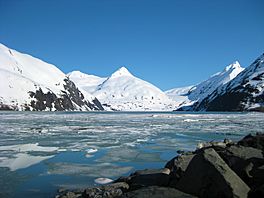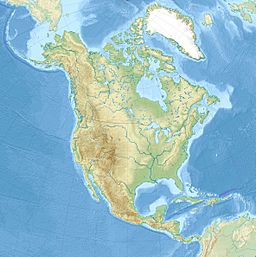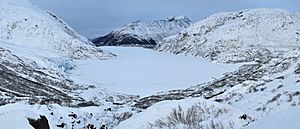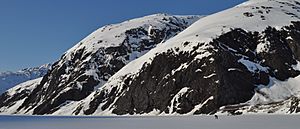Portage Lake (Alaska) facts for kids
Quick facts for kids Portage Lake |
|
|---|---|

Portage Lake, as seen from the Western edge near the Begich Boggs Visitor Center with Bard Peak in the distance
|
|
| Location | Chugach National Forest, Alaska, United States |
| Coordinates | 60°46′27″N 148°49′0″W / 60.77417°N 148.81667°W |
| Primary inflows | Placer Creek, Mallott Creek |
| Primary outflows | Portage Creek |
| Basin countries | United States |
| Max. length | 3.0 mi (4.8 km) |
| Max. width | .89 mi (1.43 km) |
| Average depth | 600 ft (180 m) |
| Islands | none |
Portage Lake is a cool lake in the Chugach National Forest in Alaska. It's a "glacial lake," which means it was formed by a huge glacier. This lake is nestled in a long valley, right next to the giant Portage Glacier. The glacier's southern end actually dips into the lake! Before about 1914, you couldn't even see Portage Lake. It only appeared as the Portage Glacier started melting and moving back quickly.
Visiting Portage Lake
It's easy to visit the western side of Portage Lake. You can find a big parking lot at the Begich Boggs Visitor Center. This center is right by the lake, just off the Portage Glacier Highway.
You can even take a special boat trip on Portage Lake! Portage Glacier Cruises offers short boat rides. These cruises take visitors close to the front of the glacier.
Fun Activities on the Lake
In the past, it was not allowed to boat on Portage Lake. This was because of big icebergs floating around. Also, the glacier's front (called its "calving face") was very active. Now, boating is allowed, but you still need to be careful. The conditions on the lake can be tricky!
When winter and spring arrive, Portage Lake becomes a popular spot for many outdoor activities. People love to go cross-country skiing and kite skiing here. You can also enjoy mountain biking, skating, snowshoe running, and hiking.
One of the most popular times is the "crust skiing" season in mid-spring. Skiers really enjoy this time! However, everyone needs to be very careful near Portage Glacier. The glacier is always moving and breaking up the ice on the lake. This can create spots of open water or weak ice, even in the middle of winter.





